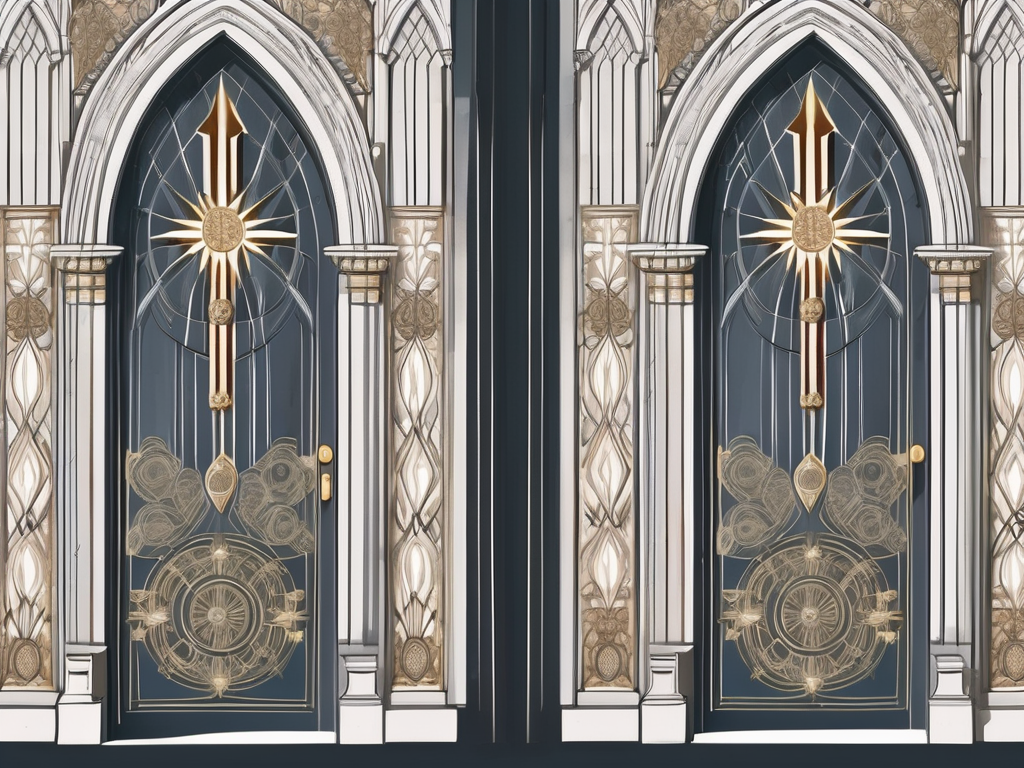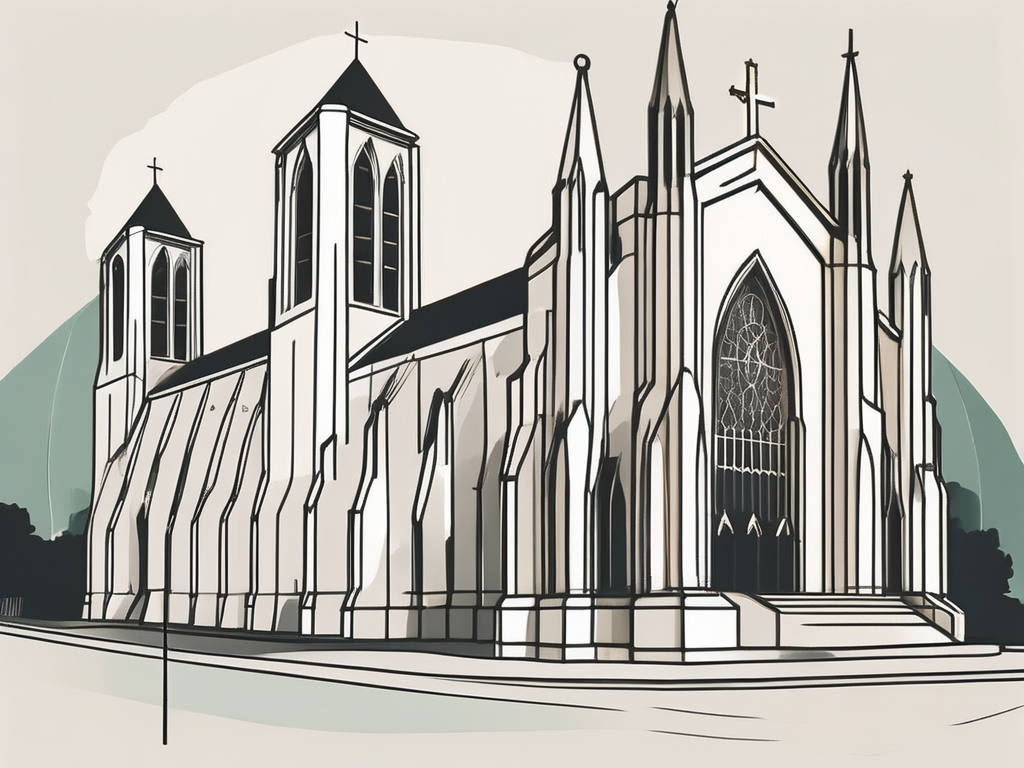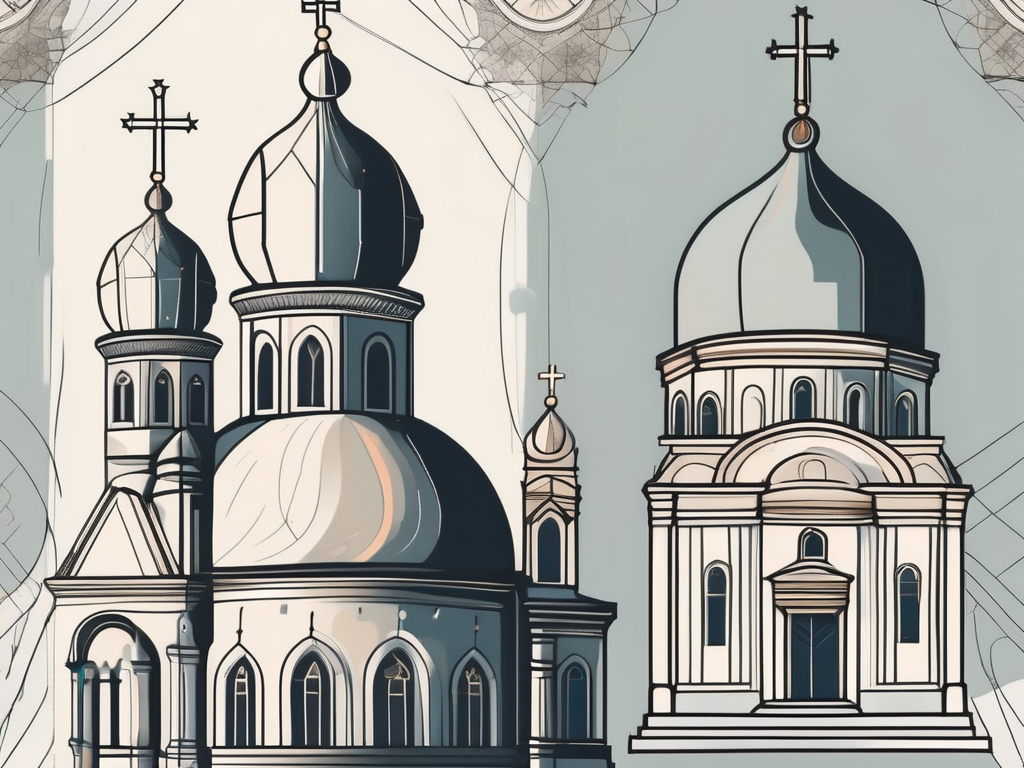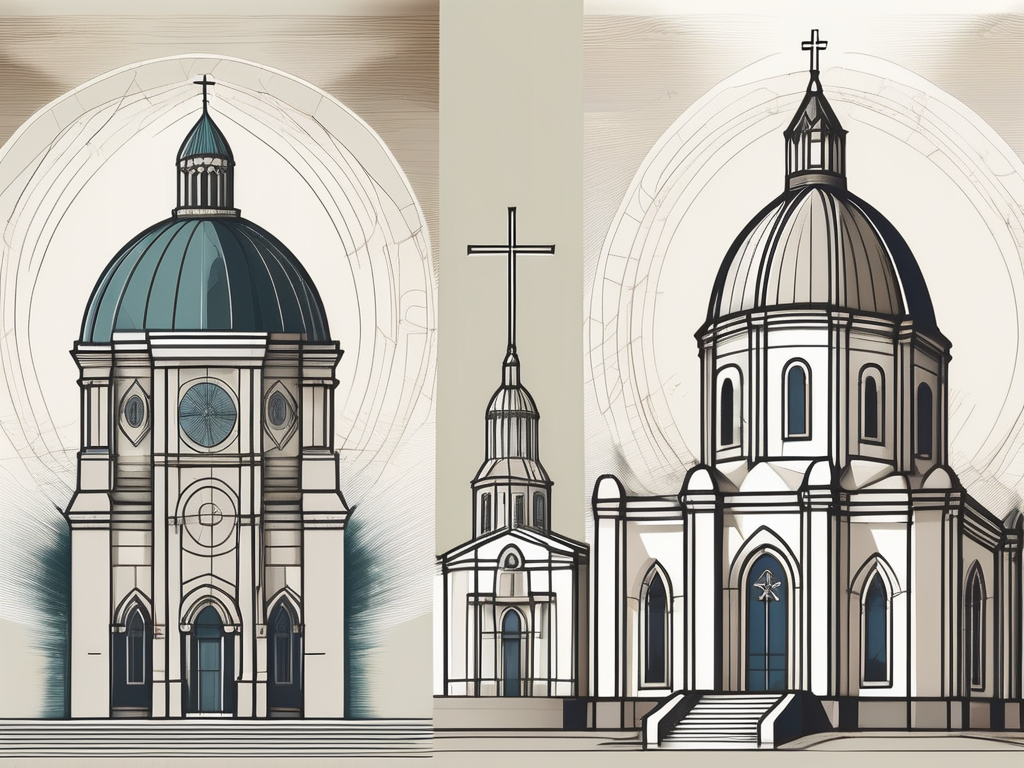Religion plays a significant role in the lives of countless individuals around the world. Among the many denominations, Protestantism and Catholicism stand as two of the most prominent branches of Christianity. Although both share a common foundation in their faith, they differ in several key aspects. To gain a deeper understanding of these differences and similarities, let’s delve into the origins, core beliefs and practices, organization of churches, rituals and sacraments, and the role of saints and icons in both denominations.
Understanding the Origins of Protestantism and Catholicism
The birth of Protestantism can be traced back to the 16th century, during a period of time known as the Reformation. This movement began with Martin Luther’s public disagreement with certain practices and teachings of the Catholic Church. Luther, along with other reformers, sought to restore what they believed were the original teachings of Christianity based on the Bible.
During the Reformation, the Catholic Church was facing criticism for various reasons. One of the main concerns was the sale of indulgences, which were seen as a way for the Church to profit from people’s sins. Luther strongly opposed this practice and believed that salvation should be based on faith alone, rather than on the purchase of indulgences.
As the Reformation gained momentum, other reformers emerged, each with their own ideas and interpretations of Christianity. John Calvin, for example, emphasized the concept of predestination, which states that God has already determined who will be saved and who will be damned. This idea challenged the Catholic belief in free will and the ability of individuals to earn their salvation through good works.
On the other hand, Catholicism has a much longer history, dating back to the time of Jesus Christ. It was established as the dominant Christian denomination in the early centuries and has continued to evolve and grow since then. The Catholic Church traces its roots to the apostle Peter, whom Jesus appointed as the leader of his disciples.
Throughout its history, the Catholic Church has played a significant role in shaping Western civilization. It has been a patron of the arts, commissioning magnificent cathedrals, sculptures, and paintings that continue to inspire awe and admiration. The Church has also been a major force in education, establishing universities and schools that have contributed to the advancement of knowledge and learning.
One of the defining characteristics of Catholicism is its hierarchical structure, with the Pope at the top as the spiritual leader of the Church. The Pope is believed to be the successor of Peter and holds the authority to interpret and guide the teachings of the Church. This centralized authority has allowed Catholicism to maintain a unified doctrine and a sense of continuity throughout the centuries.
Over time, Catholicism has faced its own challenges and controversies. The Church has been criticized for its handling of various issues, such as the Inquisition, the Crusades, and the sexual abuse scandal. These events have led to internal reforms and soul-searching within the Catholic Church, as it strives to address past mistakes and ensure a more transparent and accountable institution.
Despite their differences, both Protestantism and Catholicism share a common belief in the central tenets of Christianity, such as the divinity of Jesus Christ and the importance of faith. While they may have different interpretations and practices, these two branches of Christianity continue to shape the religious landscape and influence the lives of millions of people around the world.
Core Beliefs and Practices: A Comparative Analysis
One fundamental difference between Protestantism and Catholicism lies in their approach to authority and interpretation of scripture. Protestant churches embrace the concept of “sola scriptura,” meaning that the Bible alone is the ultimate authority in matters of faith and practice. This principle emerged during the Protestant Reformation in the 16th century, when reformers like Martin Luther and John Calvin sought to challenge the authority of the Catholic Church. They believed that the Church had strayed from the teachings of the Bible and sought to return to a more pure and authentic form of Christianity.
In contrast, Catholicism recognizes the authority of the Pope and the hierarchical structure of the Church. The Pope, believed to be the successor of Saint Peter, is considered the Vicar of Christ on Earth and has the final say in matters of doctrine and faith. Catholics believe in the combination of Scripture, Tradition, and the Magisterium (the teaching authority of the Church) as sources of divine revelation. They see the Church as the custodian and interpreter of the Scriptures, ensuring that the faithful receive the correct understanding of God’s word.
When it comes to the concept of salvation, both denominations emphasize the importance of faith. However, Catholics believe in the necessity of good works as a response to God’s grace. This belief is rooted in the teachings of Jesus and the apostles, who emphasized the importance of love and charity in the Christian life. Catholics view good works as a natural outpouring of faith, a way to express gratitude for God’s saving grace and to participate in His redemptive work.
On the other hand, many Protestant denominations uphold the belief in salvation by faith alone. This doctrine, known as “justification by faith,” was a central tenet of the Protestant Reformation. Reformers argued that salvation is a free gift from God, received through faith in Jesus Christ. They believed that good works, while important, cannot earn salvation or contribute to one’s justification before God. Instead, good works are seen as the fruit of a genuine faith, evidence of the transformative power of the Holy Spirit in the believer’s life.
It is important to note that while these differences exist, there is also significant overlap and diversity within both Protestantism and Catholicism. Within Protestantism, there are various denominations and theological traditions, each with its own distinct beliefs and practices. Similarly, within Catholicism, there are different rites and religious orders, each contributing to the rich tapestry of the Church.
Overall, the differences in authority and the understanding of salvation between Protestantism and Catholicism reflect the historical and theological developments that have shaped these two major branches of Christianity. While they may have different approaches, both traditions share a common commitment to following Jesus Christ and proclaiming the Gospel to the world.
The Structure and Organization of Protestant and Catholic Churches
The hierarchical structure of the Catholic Church is one of its defining characteristics. At the top of the hierarchy is the Pope, who serves as the spiritual leader of the Church. The Pope is believed to be the successor of Saint Peter, who was appointed by Jesus Christ as the head of the Church. The Pope’s authority extends to all aspects of the Catholic faith, including matters of doctrine, discipline, and governance. Beneath the Pope are bishops, who are responsible for overseeing specific regions or dioceses. Bishops are considered the successors of the apostles and are entrusted with the task of shepherding the faithful within their jurisdiction.
Below the bishops are priests, who are ordained ministers responsible for leading individual parishes or communities. Priests are authorized to administer the sacraments, preach the Word of God, and provide pastoral care to their congregations. They act as intermediaries between the laity and the hierarchy, ensuring the spiritual well-being of the faithful. Deacons, on the other hand, are ordained ministers who assist priests in their pastoral duties. They often serve in outreach ministries, caring for the marginalized and those in need.
This centralized structure allows for strict control and a unified doctrine across all Catholic churches worldwide. It ensures that the teachings of the Church remain consistent and that the faithful receive the sacraments and spiritual guidance in a uniform manner. The Pope’s authority, combined with the hierarchy of bishops and priests, creates a sense of unity and cohesion among Catholic communities around the globe.
Protestant churches, on the other hand, follow a more decentralized structure. They often have independent or autonomous congregations, with varying levels of hierarchical organization. Unlike the Catholic Church, there is no central figure like the Pope who holds universal authority over all Protestant churches. Instead, each congregation is led by a pastor or minister, who may have authority within their specific church but does not possess the same global authority as the Pope.
Protestant churches emphasize the priesthood of all believers, meaning that every individual has direct access to God and can interpret the Bible for themselves. This belief in the priesthood of all believers often leads to a more democratic decision-making process within Protestant churches. Congregations have the freedom to determine their own governance structure, select their leaders, and make decisions based on the consensus of their members.
While some Protestant denominations have a hierarchical structure similar to the Catholic Church, such as the Anglican Communion with its archbishops and bishops, many others prioritize the autonomy of individual congregations. This allows for a diversity of practices and beliefs within the Protestant tradition, as each congregation has the freedom to interpret and apply the teachings of the Bible in their own unique way.
Despite their differences in structure and organization, both Protestant and Catholic churches aim to fulfill the spiritual needs of their respective communities. They provide a place of worship, a sense of belonging, and opportunities for fellowship and service. Whether through the centralized authority of the Catholic Church or the decentralized autonomy of Protestant congregations, these religious institutions play a vital role in the lives of millions of believers worldwide.
Rituals and Sacraments: Protestant vs Catholic Perspectives
The Catholic Church recognizes seven sacraments: baptism, confirmation, Eucharist, penance, anointing of the sick, marriage, and holy orders. These sacraments are considered essential for spiritual growth and the forgiveness of sins.
Protestant churches typically acknowledge only two sacraments: baptism and communion (also known as the Lord’s Supper or Eucharist). Their focus is often more symbolic, viewing these sacraments as acts of obedience and remembrance rather than channels of divine grace.
Let’s delve deeper into the significance and practices of these sacraments in both Protestant and Catholic traditions.
In the Catholic Church, baptism is seen as the gateway to the other sacraments. It is the sacrament through which a person becomes a member of the Church and is cleansed of original sin. The ritual involves the pouring or immersion of water, symbolizing purification and rebirth. Confirmation, on the other hand, is the sacrament in which a baptized person receives the Holy Spirit and is sealed with the gifts of the Spirit. This sacrament is often accompanied by anointing with holy chrism oil and the laying on of hands by a bishop.
The Eucharist, also known as the Holy Communion, is considered the most important sacrament in the Catholic Church. It is the sacrament in which the bread and wine are believed to be transformed into the body and blood of Jesus Christ. Catholics believe that through the Eucharist, they receive the real presence of Christ and are united with Him and the Church. The ritual of the Eucharist involves the consecration of bread and wine by a priest, who then distributes them to the faithful.
Penance, also known as confession or reconciliation, is the sacrament through which Catholics seek forgiveness for their sins. It involves the confession of sins to a priest, who acts as a mediator between the penitent and God. The priest then provides absolution and assigns a penance, which may include prayers or acts of charity, as a means of making amends.
Anointing of the sick, also known as the sacrament of the anointing of the sick or last rites, is administered to those who are seriously ill or facing the possibility of death. Through this sacrament, Catholics believe that the sick person receives spiritual healing and strength. The ritual involves the anointing of the forehead and hands with holy oil, accompanied by prayers for healing and forgiveness.
Marriage is considered a sacrament in the Catholic Church, symbolizing the union of Christ and the Church. It is a lifelong commitment between a man and a woman, intended to be a reflection of God’s love. The ritual of marriage involves the exchange of vows and rings, as well as the blessing of the couple by a priest or deacon.
Holy orders is the sacrament through which men are ordained as deacons, priests, or bishops in the Catholic Church. It is a calling to serve God and His people in a specific role within the Church. The ritual of ordination involves the laying on of hands by a bishop and the prayer of consecration.
In contrast, Protestant churches have a different perspective on sacraments. Baptism is seen as a symbolic act of obedience and public declaration of faith. It is a ritual that signifies a person’s identification with Christ and their commitment to follow Him. Communion, or the Lord’s Supper, is also viewed symbolically in most Protestant traditions. It is a commemoration of Jesus’ sacrifice on the cross and a reminder of His presence among believers.
While the number of sacraments and their theological significance may differ between Protestant and Catholic traditions, both emphasize the importance of these rituals in the spiritual journey of believers. Whether seen as channels of divine grace or acts of obedience and remembrance, sacraments hold a central place in the worship and practice of both Protestant and Catholic churches.
The Role of Saints and Icons in Both Denominations
The veneration of saints and icons is a significant aspect of Catholicism. Saints, believed to be holy individuals who have achieved a closer union with God, are revered and celebrated. Icons, religious images or symbols, are used as aids in prayer and worship.
In contrast, Protestant denominations generally do not venerate saints or icons in the same manner. They often criticize the Catholic practice, considering it to be a form of idolatry. Instead, many Protestants focus primarily on their personal relationship with God and Jesus Christ.
By unraveling the differences and similarities between Protestantism and Catholicism, we gain a deeper understanding of these two influential branches of Christianity. Whether it’s the diverse approaches to authority, the distinctive church structures, or the contrasting views on rituals and saints, these variations shape the experiences and beliefs of millions worldwide. Ultimately, despite their dissimilarities, both Protestantism and Catholicism share a common foundation centered on the teachings of Jesus Christ and the pursuit of faith.












